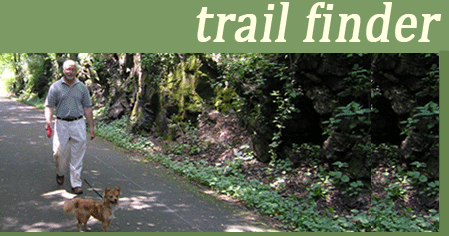
Visit TrailFinder at www.ptny.org/trailfinder
Parks & Trails New York has launched a new on-line guide to multi-use trails in New York State, just in time for the best outdoor season of the year--fall. Called TrailFinder, the site focuses on trails and greenways that allow multiple uses—such as walking, bicycling, in-line skating, cross-country skiing and, in some cases, horseback riding and snowmobiling.
TrailFinder includes 11 trails, totaling more than 1200 miles.
Visitors will be able to plan their trail adventures in just a few minutes at the computer – with key information at their fingertips.
Visitors to TrailFinder can search for trails in several ways. They can select a trail from a drop-down menu, query by trail attributes such as length, surface, allowable uses, and distance from a particular location, or browse the interactive map. Trailhead parking areas are included, as are directions and nearby bike shops and other amenities such as bicycle-friendly bed & breakfasts.
Parks & Trails New York developed TrailFinder to make people more aware of the vast resource of multi-use trails and greenways in New York and to make it easier for people to enjoy them.
Parks & Trails New York Executive Director Robin Dropkin hopes that TrailFinder will build support for the vital and growing trail movement in New York. She also hopes the new website will spur more communities to develop trails and encourage bicycle tourism, which will foster the protection and re-use of abandoned transportation corridors throughout the state.
“I think people will be amazed at the extent of the multi-use trail system in New York. The potential for creating one of the best statewide multi-use trail networks is fantastic,” says Dropkin. “With NewYork’s abundance of abandoned railroads, historic canals, and scenic rivers, it’s possible to create a dynamic system of multi-use trails serving communities in every corner of the state, with major statewide trail systems—such as the Erie Canalway Trail, Genesee Valley Greenway, and Hudson River Valley Greenway—as the backbone of the network.”
Trails a boon to local economies
Trails and greenways provide a wide range of benefits to communities. They make it easier for people to keep fit and have fun by providing close-to-home recreational opportunities. They provide safe places to walk or bike to work, school, or local shops. They also protect open space, attract tourists and add to the quality of life.
“Trail use is part of the new economy of New York tourism, especially upstate,” says Dropkin. “A major National Park Service study of three multi-use trails around the country found that trail use pumped between $1.2 and $1.9 million annually into the economies of nearby communities.”
Bicycle-friendly B&B’s and accessibility information featured
Featured in the TrailFinder site are convenient bed & breakfasts and inns that cater to the needs of cyclists. All are members of the Empire State Bed and Breakfast Association (ESBBA) that have pledged to offer bicycle-friendly amenities, including covered and locked bicycle storage, tools for minor bike repairs, no-smoking rooms, and healthy and filling breakfasts.
Accessibility information is available for some trails so that before ever reaching the trailhead, visitors will have the data to decide whether a trail is right for them. While especially useful for persons with disabilities, older adults and parents with young children may find this information helpful, too.

![Reblog this post [with Zemanta]](http://img.zemanta.com/reblog_e.png?x-id=30ee0d17-7f17-41b4-940b-69ae4a9351c7)






